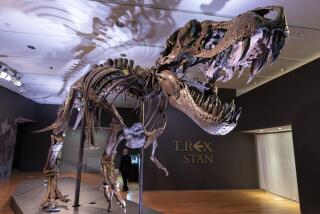Dinosaurs and their ancestors lived side by side, fossils show
- Share via
Scientists have discovered dinosaur fossils sharing space with two lagerpetids — a group of animals thought to be the precursors to dinosaurs.
The findings, described in the journal Current Biology, show that dinosaurs and their ancestors may have coexisted for a while, and could shed light on the differences that emerged as dinosaurs evolved and spread.
The fossils of two small dinosaurs and two lagerpetids, which were discovered in southern Brazil around a town called São Sao Joao de Polesine, include a partial lagerpetid and a partial sauropodomorph (a group of dinosaurs that includes sauropods like Apatosaurus).
Researchers have discovered evidence of dinosaurs and lagerpetids living together relatively late in the game (close to the end of the Triassic age, 228 million to 201 million years ago). But the new lagerpetid specimen (Ixalerpeton polesinensis) and the dinosaur (Buriolestes schultzi) were actually taken from one of the world’s oldest rock units with dinosaur fossils, stretching from 237 million to 228 million years ago.
“This is the first time nearly complete dinosaur and non-dinosaur dinosauromorph remains are found together in the same excavation, clearly showing that these animals were contemporaries since the first stages of dinosaur evolution,” the study authors wrote.
In fact, these two groups of animals probably shared the Earth for about 30 million years, said study co-author Max Cardoso Langer, a paleontologist at the University of Sao Paulo.
“We previously thought that once dinosaurs appeared, they sort of out-competed and drove the other animals like lagerpetids to extinction,” Langer said, “and now we know that they were living side by side.”
Sauropods were herbivores, and sauropodomorphs ate plants even if they also ate animals. But based on its teeth, Buriolestes, which may have stretched a meter and a half long, was probably a pure carnivore, eating smaller critters (probably including Ixalerpeton). Ixalerpeton stretched about half a meter long and probably ate insects and small invertebrates.
So the earliest sauropodomorphs appear to have been carnivores and walked on two legs — very unlike their herbivorous, four-legged descendants, Langer said.
The scientists think Buriolestes might represent one of the earliest of the sauropodomorphs — and being able to compare the skeletons of the dinosaur and of Ixalerpeton is helping them figure out how dinosaurs may have started diverging from their ancestors.
“We can know which characteristics are actually unique to dinosaurs and which appeared before in those precursors,” Langer said.
Follow @aminawrite on Twitter for more science news and “like” Los Angeles Times Science & Health on Facebook.
MORE IN SCIENCE
Why are we ticklish? Scientists who tickled rats offer an intriguing answer
A small step for monkeys is a giant leap toward helping paralyzed people walk again
Elephant poachers are hard at work in Africa, and carbon dating proves it







